
The dispute over capacity tax deepened on Friday after the federal government increased tax rates on production capacity of aerated water in the range of 60% to 70% succumbing to pressure from three manufacturers.
The rates of capacity tax on production of aerated water were increased for all the three categories, according to a notification issued by the Federal Board of Revenue (FBR). This has increased the burden not only on small manufacturers that have already gone to court but also on major players except for the three.
The FBR increased the tax rates despite the fact that Finance Minister Ishaq Dar and FBR Chairman Tariq Bajwa had reservations over the capacity tax regime, said sources.
These three were allegedly being given benefits for being financiers of the ruling party, the sources added.
According to industry sources, other main bottlers having manufacturing licences for Lahore and surrounding areas, Karachi and allied territories, Sukkur and Islamabad-Peshawar have decided to knock the door of courts. There is a possibility that the manufacturer covering Islamabad and Peshawar may go to court in the second phase.
According to the notification, the tax rate of Rs4.7 million per filling valve or spout on factories, which only have foreign-origin filling machines or a mix of foreign and local-origin machines, has been increased 60% to Rs7.5 million.
Tax rate for the second category, which includes factories using local machinery, has been increased from Rs3.76 million per filling valve to Rs6 million, an increase of 61.2%.
For the third category, which includes factories with less than 40 filling valves or spouts, the rate has been increased from Rs1.2 million per filling valve to Rs2 million, up 70%.
The system was highly unfair as the tax rate on higher-speed filling valve and lower-speed filling valve was the same, giving benefit to major players, said a small manufacturer whose company has already gone to court.
The increase in tax rates left the manufacturers with no option but to increase prices of aerated waters, said a big manufacturer, who has decided to file a petition against the government.
The change in the mode of taxation from percentage to fixed amount has already made many small and medium-sized players uncompetitive. In current year’s budget, the PML-N government increased the federal excise duty on aerated water from 6% to 9%. However, on the recommendation of the three players, the capacity tax was introduced.
The three had assured the government that with the change in tax regime, the FBR’s collection from the beverages industry will rise 25% compared to previous year. In the last fiscal year, the FBR had collected Rs30 billion.
However, in the first half of current year, the results were dismal, proving the three players wrong, according to FBR officials. Now, tax rates have been revised to prove that their claims were achievable.
Despite a significant increase in the tax rates, the obligations of the three players were not likely to go up, as they were under-declaring their capacity to evade taxes, said sources in the beverages industry.
Through the same notification, the government has capped tax refunds of the beverages industry at 72% of payable gross amount. This will also increase the cost of doing business.
For instance, on a payment of Rs37.5 million, the FBR will hold Rs3 million in refund. This will block working capital of the manufacturers, as the FBR has had a bad track record in paying the taxpayers’ rightful refunds.
Published in The Express Tribune, March 1st, 2014.
Like Business on Facebook, follow @TribuneBiz on Twitter to stay informed and join in the conversation.



1732184775-0/BeFunky-collage-(80)1732184775-0-165x106.webp)













COMMENTS
Comments are moderated and generally will be posted if they are on-topic and not abusive.
For more information, please see our Comments FAQ